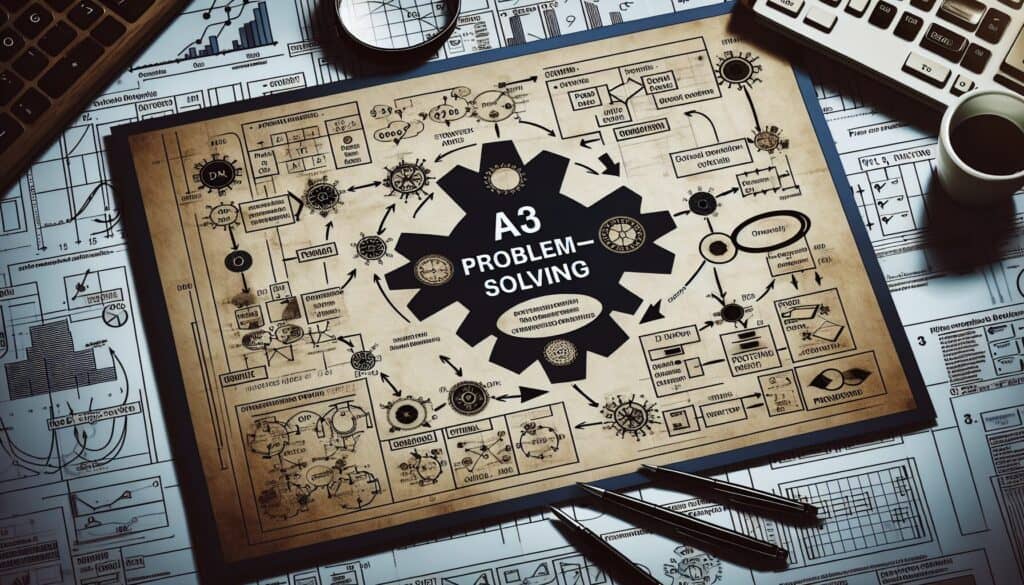A structured problem-solving and continuous improvement approach, typically documented on a single A3-sized sheet of paper that follows a logical thinking process, thus “A3 Thinking“ (often aligned with PDCA).
- Methodologies: Customers & Marketing, Economics, Lean Sigma, Manufacturing, Project Management, Quality
A3 Thinking

A3 Thinking
- Continuous Improvement, Lean Manufacturing, Plan–Do–Check–Act (PDCA), Problem Solving Techniques, Process Improvement, Quality Control, Quality Management, Root Cause Analysis, Teamwork
Objective:
How it’s used:
- The A3 report typically includes sections for: Background/Problem Statement, Current Condition, Goal/Target Condition, Root Cause Analysis, Proposed Countermeasures, Implementation Plan, Follow-up/Results, and Standardization. It's a collaborative tool.
Pros
- Promotes clear and concise communication of problems and solutions; Encourages systematic thinking and data-driven analysis; Facilitates collaboration and knowledge sharing; Serves as a powerful coaching and mentoring tool.
Cons
- Can be challenging to condense complex problems onto a single A3 sheet effectively; Requires skill in facilitation and root cause analysis; May be perceived as just a documentation exercise if the underlying thinking process is not embraced.
Categories:
- Lean Sigma, Manufacturing, Problem Solving, Project Management, Quality
Best for:
- Solving problems systematically, driving continuous improvement, and fostering a culture of learning and clear communication, often within a Lean environment.
A3 Thinking finds its applications across various sectors including manufacturing, healthcare, and software development, particularly within organizations that prioritize Lean methodologies. For instance, in manufacturing, A3 reports can be utilized to tackle production inefficiencies by analyzing workflow bottlenecks and developing targeted solutions, while in healthcare, these reports can help streamline patient care processes by identifying root causes of delays in treatment. The methodology is most effective during the problem identification phase, where teams can collaboratively articulate issues and devise a common understanding before moving into solution development. Participants typically include cross-functional team members, project managers, and stakeholders who bring diverse perspectives to the table, which enhances collaboration and ensures that all aspects of a problem are addressed. The A3 report structure provides a clear framework that guides teams through systematic analysis and encourages the use of data-driven decision-making, which can lead to sustainable improvement initiatives. With ongoing follow-up and results tracking, organizations can establish standard practices that integrate lessons learned, promoting a continuous improvement culture that values learning and adaptability among team members. The clarity of communication inherent in A3 reports serves as a mentoring tool that allows less experienced team members to efficiently grasp problem-solving techniques from their peers, thereby building a stronger foundation for future projects.
Key steps of this methodology
- Define the background and problem statement clearly.
- Analyze the current condition with relevant metrics.
- Set a specific goal or target condition to achieve.
- Conduct root cause analysis using appropriate techniques.
- Propose countermeasures based on the root causes identified.
- Develop a detailed implementation plan for the countermeasures.
- Establish a follow-up process to monitor results.
- Document lessons learned and standardize successful practices.
Pro Tips
- Involve cross-functional teams early to enhance diverse perspectives in problem-solving.
- Utilize data visualization methods, like flowcharts or graphs, to clarify current conditions and root cause analysis.
- Establish clear metrics for success at the goal/target condition stage to measure impact effectively post-implementation.
To read and compare several methodologies, we recommend the
> Extensive Methodologies Repository <
together with the 400+ other methodologies.
Your comments on this methodology or additional info are welcome on the comment section below ↓ , so as any engineering-related ideas or links.
Historical Context
1949
1950
1950
1960
1960
1960
1960
1940
1950
1950
1958
1960
1960
1960
1960
(if date is unknown or not relevant, e.g. "fluid mechanics", a rounded estimation of its notable emergence is provided)















Related Posts
Musculoskeletal Discomfort Questionnaires
Multivariate Testing (MVT)
Multiple Regression Analysis
Motion Capture Systems
MoSCoW Method
Mood’s Median Test